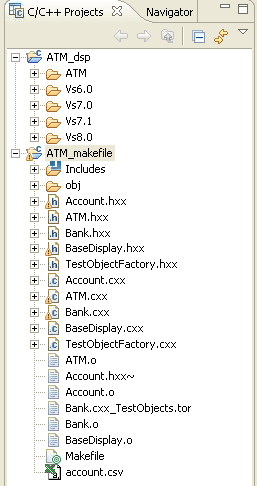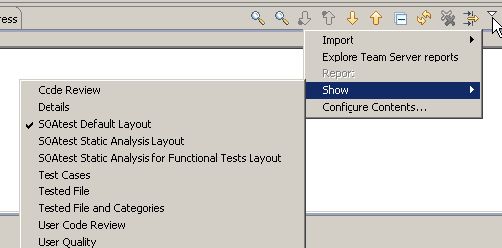The following views are available:
C/C++ Projects view
The C/C++ Projects view is typically on the left hand side of the workbench (GUI). It lists the available projects and elements related to those projects. You will use the C/C++ Projects view to indicate which resource or set of resources you want C/C++test to operate on.
In this guide, the C/C++ Projects view is also referred to as "the project tree."
This view is shown by default.
Coverage view
The Coverage view reports the amount of coverage obtained for the selected resource during the most recent test case execution.
This view is open by default. If this view is not available, choose Parasoft> Show View> Coverage to open it.
For details on reviewing coverage, see Reviewing Coverage Information.
Stubs view
The Stubs view provides details on the stub configuration based on the most recent run of a unit testing Test Configuration. It allows you to modify the configuration by adding user-defined stubs or automatically generating stubs for missing symbols.
To display this view, choose Parasoft> Show View> Stubs.
For details on this view, see Adding and Modifying Stubs.
Test Progress view
This is view is where C/C++test reports test progress and status.
When a test runs, the view label changes from "Test Progress" to "[Test Configuration name]".
The Review tasks button displays the results in the Quality Tasks view.
A results summary for each analysis category is available in expandable sections.
Toolbar Buttons
The toolbar buttons allow you to:
- Generate reports (see Generating Reports)
- Show/hide details (including information on any setup problems related to building, compilation, etc.).
Terms Used
The following Scope metrics are reported for all types of tests and analysis:
- Total Files: The number of files from the original selection that the Test Configuration has recognized as being suitable for the selected type of test or analysis. For instance, for Java static analysis, this will be the number of java/jsp files contained in the original selection.
- Source Files to Check: The number of files that meet the criteria in the Scope file filters. This is a subset of the total files. For example, if the Scope filter is set with Test only files modified locally enabled, then this metric would report the number of locally-modified files.
- Total Source Lines: The number of all lines of source code in the 'Source Files to Check'. If a file has been rejected by the Scope file filter, then its lines are not counted.
- Source Lines to Check: The number of lines that have been accepted by Scope line filters. This is a subset of the total source lines. For example, if the Scope filter is set with Test only lines modified locally enabled, then this metric will report the number of locally-modified lines.
Quality Tasks view
The Quality Tasks view is where C/C++test lists quality tasks and code review tasks. You can determine which type of task is displayed by clicking the appropriate button in the view’s toolbar or by choosing it from the view’s drop-down menu, as shown below.
To learn about the general strategies for reviewing the results reported in this view, see Reviewing Results. For details about exploring product-specific results (e.g., special right-click menu commands, more details about what details are presented for various results categories, etc.), see the related product’s user’s guide.
Test Case Explorer view
The Test Case Explorer helps you manage a project’s test cases, test suites, and related data sources. It provides detailed test statistics and allows you to search/filter the test case tree.
To display this view, choose Parasoft> Show View> Test Case Explorer.
For details on this view, see About the Test Case Explorer.
Editor view
The Editor view is the largest panel in the workbench. This is where C/C++test displays the source files and test files which you open for editing. In some cases, it also provides editors for configuring tools, test cases, objects, etc.
To create an editor for a file or other test artifact, double-click the related node in the project tree.
If you right-click within a file open in the Editor view, relevant commands will be available in a Parasoft shortcut menu. For Eclipse, Parasoft-specific commands are added to the Show In shortcut menu (for example, Show In> Quality Tasks).
Suppressions view
The Suppressions view lists any suppressed static analysis tasks from suppressions that were defined in the GUI (as opposed to suppressions defined directly in the code; those suppressions are not shown in this view).
This view is not open by default. Choose Parasoft> Show View> Suppressions to open it.
For details on using suppressions, see the Static Analysis section in the related product’s user’s guide.
Code Review Issue view
The Code Review Issue view allows team members to add and review code comments about the submitted code modifications. This allows the author and reviewer to have a conversation about how to revise a submitted revision. To access this view, choose Parasoft> Show View> Code Review Issue.
For details on code review, see Code Review.
Console view
The Console view is where C/C++test lists the output of the entire test process. It displays details such as the process command lines, output, test case details, and logs. Test execution details are reported to the Console tab during test execution, and remain there until they are cleared or until another test is run.
To display this view, choose Window Show View> General> Console.





